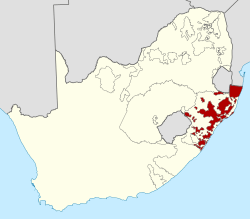KwaZulu
KwaZulu was a semi-independent bantustan in South Africa, intended by the apartheid government as a homeland for the Zulu people. The capital was moved from Nongoma to Ulundi in 1980.
KwaZulu | |||||||||
|---|---|---|---|---|---|---|---|---|---|
| 1977–1994 | |||||||||
.svg.png) Flag
 Coat of arms
| |||||||||
 Location of KwaZulu (red) within South Africa (yellow). | |||||||||
| Status | Bantustan | ||||||||
| Capital | Nongoma (to 1980) Ulundi (1980–1994) | ||||||||
| Common languages | Zulu English Afrikaans | ||||||||
| Government | |||||||||
• Chief Minister | Mangosuthu Buthelezi | ||||||||
| History | |||||||||
• Self-government | 1 February 1977 | ||||||||
• Re-integrated into South Africa | 27 April 1994 | ||||||||
| Area | |||||||||
| 1980[1] | 32,130 km2 (12,410 sq mi) | ||||||||
| Population | |||||||||
• 1980[1] | 3,400,000 | ||||||||
• 1991[2] | 5,524,774 | ||||||||
| Currency | South African rand | ||||||||
| |||||||||
It was led until its abolition in 1994 by Chief Mangosuthu Buthelezi and head of Inkatha, who implemented the limited self-governing powers decided by the South African government as part of apartheid, but rejected the nominal independence which four other homelands accepted, complaining about the fragmented nature of the state, and the inability of the apartheid government to consolidate a viable and contiguous territory for KwaZulu, in the face of stiff resistance from whites.[3] F. W. de Klerk later commented in an interview that he believed that Buthelezi would have accepted independence had his homeland been given the port of Richards Bay, a proposal that failed due to the white population's resistance to the idea.[4][3]
It was merged with the surrounding South African province of Natal to form the new province of KwaZulu-Natal.
The name kwaZulu translates roughly as Place of Zulus, or more formally Zululand.
In March 1996, two years after South Africa's transition to majority rule, the trial of The State v. Peter Msane & Others was held due to the accusation against thirteen retired white generals, including Magnus Malan (who served as defence minister at the height of emergency rule in the mid-1980s) and seven Zulus, partisans of Buthelezi's Inkatha Freedom Party of complicity in a massacre of thirteen people, ten years earlier, in a rural village in the KwaZulu homeland known as KwaMakhutha.[5] The trial was an attempt by Nelson Mandela's new government to bring to justice those at the top of apartheid's security forces. They were alleged to have purposefully fanned violence among blacks by arming and training one faction as a proxy force, in the tradition of divide and rule.[5] However, all of the defendants were acquitted.
Districts in 1991
Districts of the province and population at the 1991 census.[2]
- Ezingolweni: 215,224
- Emzumbe: 217,399
- Vulamehlo: 125,179
- Embumbulu: 271,215
- Umlazi: 299,275
- Hlanganani: 186,712
- Ndwedwe: 318,093
- Vulindlela: 223,706
- Empumalanga: 314,440
- Ntuzuma: 458,529
- Kwa Mapumulu: 231,503
- Ongoye: 175,993
- Inkanyezi: 170,628
- Nkandla: 132,578
- Nqutu: 213,636
- Msinga (main town Tugela Ferry):[6] 154,623
- Emnambithi: 205,639
- Enseleni: 241,005
- Hlabisa: 169,719
- Mahlabatini: 141,284
- Nongoma: 169,153
- Ubombo: 113,409
- Ingwavuma: 144,613
- Simdlangentsha: 120,368
- Madadeni: 313,888
- Okhahlamba: 196,963
See also
- Chief Ministers of KwaZulu
References
- Sally Frankental; Owen Sichone (2005-01-01). South Africa's Diverse Peoples: A Reference Sourcebook. ABC-CLIO. p. 187. ISBN 978-1-57607-674-3. Retrieved 2013-09-18.
- "Census > 1991 > RSA > Variable Description > Person file > District code". Statistics South Africa - Nesstar WebView. Archived from the original on 19 June 2016. Retrieved 18 August 2013.
- South African Democracy Education Trust (2004). The Road to Democracy in South Africa: 1970-1980. Unisa Press. pp. 821–. ISBN 978-1-86888-406-3.
- https://www.independent.co.uk/news/world/africa/fw-de-klerk-the-day-i-ended-apartheid-1886128.html
- Berkeley, Bill (2001). The Graves are Not Yet Full.
- "Dictionary of Southern African Place Names (Public Domain)". Human Science Research Council. p. 319.